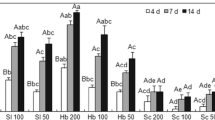Abstract
The entomopathogenic nematodeHeterorhabditis bacteriophora Pionar (HP 88) and the bacteriumBacillus thuringiensis Berliner var.kurstaki were tested in the laboratory against the black cutworm, a widely distributed polyphagous insect pest of vegetables and field crops. The experiment was conducted under 15.7 °C (14 to 19 °C) to simulate the average winter temperature in Egypt. The two biocontrol agents influencedAgrotis ipsilon differently whereH. bacteriophora had a more promising control levels than that ofB. thuringiensis. Generally, nematode concentration of ca 500 infective juveniles/insect vial was highly effective (100% mortality) within nine days post nematode infection. The highest concentration of the bacteriumB. thuringiensis var.kurstaki (2,000 Intern. Units/mg) gave significant larval control after 12 days of bacterial infection. Combined effect of both the nematodes and the bacteria did not result in significantly greater control than that achieved by the nematodes used alone. The present results indicated that nematodes could be used successfully against the black cutworm,Agrotis ipsilon larvae during the winter which is the active season of this insect pest in Egypt.
Similar content being viewed by others
References
Abbot, W. W., 1925: A method of computing the effectiveness of an insecticide. J. Econ. Entomol.18, 265–267.
Abdel-Kawy, A. M., 1985: Biological control of some lepidopterous pests by the nematodesNeoaplectana carpocapsae and the physiological changes associated with it. Ph. D. thesis Fac. Agric., Cairo Univ.
Abd-Elsalam, A. L., 1993: Insect pests in Egypt and Arab countries and their controlling methods. Part I and II. Modern Egyptian Press, Egypt.
Bari, M. A.;Kaya, H. K., 1984: Evaluation of the entomogenous nematodeNeoaplectana carpocapsae (=Steinernema feltiae) Weiser (Rhabditida: Steinernematidae) and the bacteriumBacillus thuringiensis Berliner var.kurstaki for suppression of the Artichoke Plume Moth (Lepidoptera: Pterophoridae). J. Econ. Entomol.77 (1), 225–229.
El-Bishry, M. H., 1994: Interaction between entomopathogenic nematodes andBacillus thuringiensis: a new approach for biological control of insects. Egypt. J. Biol. Pest Control4 (1), 105–111.
Gaugler, R.;Boush, G. M., 1979: Nonsusceptibility of rates of the entomogenous nematodes,Neoaplectana carpocapsae. Environ. Entomol.8, 658.
Gaugler, R., Kaya, H. K. (eds.), 1990: Entomopathogenic nematodes in biological control. CRC Press, Boca Raton, Florida, USA.
Georgis, R.;Gaugler, R., 1991: Predictability in biological control using entomopathogenic nematodes. J. Econ. Entomol.84, 713–720.
Gorsuch, A. M., 1982: Regulations for the enforcement of the Federal Insecticide, Fungicide, and Rodenticide Act (FIFRA) exemption from regulation of certain biological control agents. Fed. Regist.47, 23928–23930.
Kaya, H. K.;Burlando, T. M., 1989: Development ofSteinernema feltiae (Rhabditida: Steinernematidae) in diseased insect hosts. J. Invertebr. Pathol.53, 164.
Salama, H. S.;Foda, M. S.;Dulmage, H. T.;El-Sharaby, A., 1983: Novel fermentation media for production of Delta-Endotoxins fromBacillus thuringiensis. J. Invertebr. Pathol.41, 8–19.
Salama, H. S.;Moawed, S. M.;Zaki, F. N., 1987: Effects of nuclear polyhedrosis virus —Bacillus thuringiensis combinations onSpodoptera littoralis (Boisd.). Z. ang. Ent.104, 23–27.
Salama, H. S.;Zaki, F. N.;Salem, S., Ragaei, M., 1995: The use ofBacillus thuringiensis to control two lepidopterous insect pests (Agrotis ypsilon andSpodoptera littoralis). Anz. Schädlingskde., Pflanzenschutz, Umweltschutz68, 15–17.
Sebesta, K.;Farkas, J.;Horsha, K.;Vankova, J., 1981:Bacillus thuringiensis. In:Burgess, H. D. (ed): Microbial control of pests and plant diseases. 1970–1980. Acad. Press, London, pp. 249–281.
White, G. F., 1927: A method for obtaining infective nematode larvae from cultures. Science66, 302–303.
Author information
Authors and Affiliations
Rights and permissions
About this article
Cite this article
Shamseldean, M.M.M., Ismail, A.A. Effect of the nematodeHeterorhabditis bacteriophora and the bacteriumBacillus thuringiensis as integrated biocontrol agents of the black cutworm. Anz. Schadlingskde., Pflanzenschutz, Umweltschutz 70, 77–79 (1997). https://doi.org/10.1007/BF02039133
Issue Date:
DOI: https://doi.org/10.1007/BF02039133




